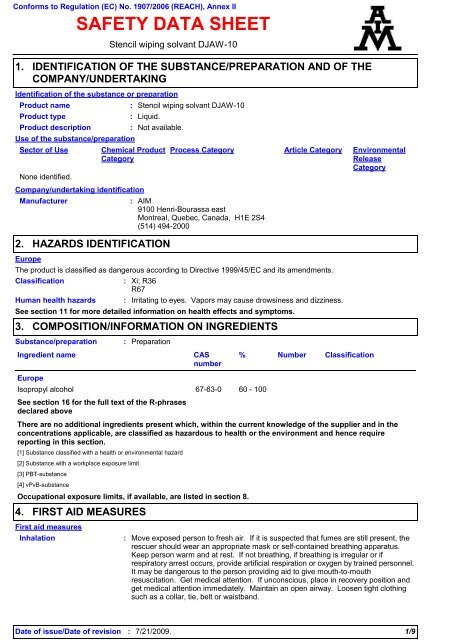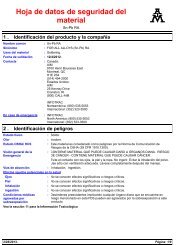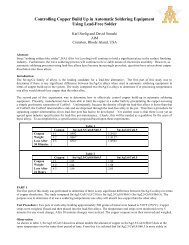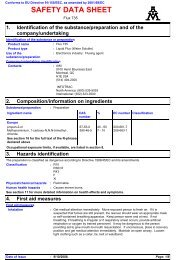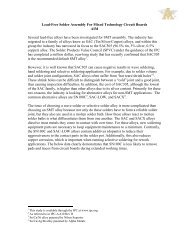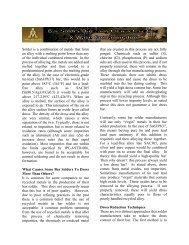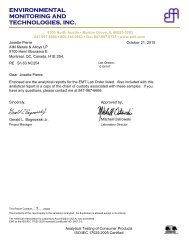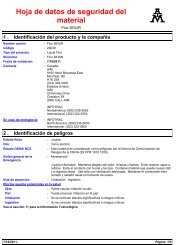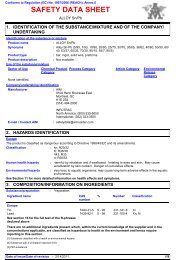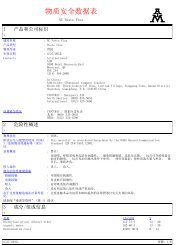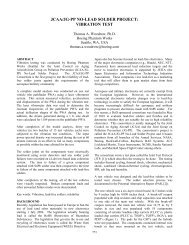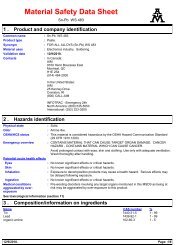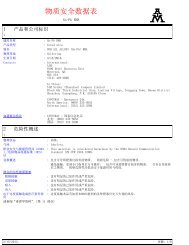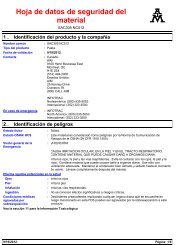DJAW-10 - AIM Solder
DJAW-10 - AIM Solder
DJAW-10 - AIM Solder
You also want an ePaper? Increase the reach of your titles
YUMPU automatically turns print PDFs into web optimized ePapers that Google loves.
Conforms to Regulation (EC) No. 1907/2006 (REACH), Annex II<br />
1.<br />
SAFETY DATA SHEET<br />
IDENTIFICATION OF THE SUBSTANCE/PREPARATION AND OF THE<br />
COMPANY/UNDERTAKING<br />
Product name<br />
Manufacturer :<br />
Stencil wiping solvant <strong>DJAW</strong>-<strong>10</strong><br />
Identification of the substance or preparation<br />
Product type :<br />
Product description<br />
Use of the substance/preparation<br />
Sector of Use<br />
None identified.<br />
Company/undertaking identification<br />
2.<br />
Europe<br />
:<br />
Stencil wiping solvant <strong>DJAW</strong>-<strong>10</strong><br />
Liquid.<br />
: Not available.<br />
Chemical Product<br />
Category<br />
HAZARDS IDENTIFICATION<br />
Process Category Article Category Environmental<br />
Release<br />
Category<br />
<strong>AIM</strong><br />
9<strong>10</strong>0 Henri-Bourassa east<br />
Montreal, Quebec, Canada, H1E 2S4<br />
(514) 494-2000<br />
The product is classified as dangerous according to Directive 1999/45/EC and its amendments.<br />
Classification<br />
: Xi; R36<br />
R67<br />
Human health hazards : Irritating to eyes. Vapors may cause drowsiness and dizziness.<br />
See section 11 for more detailed information on health effects and symptoms.<br />
3.<br />
COMPOSITION/INFORMATION ON INGREDIENTS<br />
Substance/preparation<br />
Ingredient name<br />
Europe<br />
:<br />
Preparation<br />
CAS<br />
number<br />
Isopropyl alcohol 67-63-0 60 - <strong>10</strong>0<br />
See section 16 for the full text of the R-phrases<br />
declared above<br />
[1] Substance classified with a health or environmental hazard<br />
[2] Substance with a workplace exposure limit<br />
Occupational exposure limits, if available, are listed in section 8.<br />
% Number Classification<br />
There are no additional ingredients present which, within the current knowledge of the supplier and in the<br />
concentrations applicable, are classified as hazardous to health or the environment and hence require<br />
reporting in this section.<br />
[3] PBT-substance<br />
[4] vPvB-substance<br />
4.<br />
FIRST AID MEASURES<br />
First aid measures<br />
Inhalation :<br />
Move exposed person to fresh air. If it is suspected that fumes are still present, the<br />
rescuer should wear an appropriate mask or self-contained breathing apparatus.<br />
Keep person warm and at rest. If not breathing, if breathing is irregular or if<br />
respiratory arrest occurs, provide artificial respiration or oxygen by trained personnel.<br />
It may be dangerous to the person providing aid to give mouth-to-mouth<br />
resuscitation. Get medical attention. If unconscious, place in recovery position and<br />
get medical attention immediately. Maintain an open airway. Loosen tight clothing<br />
such as a collar, tie, belt or waistband.<br />
Date of issue/Date of revision : 7/21/2009.<br />
1/9
Stencil wiping solvant <strong>DJAW</strong>-<strong>10</strong><br />
4. FIRST AID MEASURES<br />
Ingestion<br />
:<br />
Wash out mouth with water. Remove dentures if any. Move exposed person to<br />
fresh air. Keep person warm and at rest. If material has been swallowed and the<br />
exposed person is conscious, give small quantities of water to drink. Stop if the<br />
exposed person feels sick as vomiting may be dangerous. Do not induce vomiting<br />
unless directed to do so by medical personnel. If vomiting occurs, the head should<br />
be kept low so that vomit does not enter the lungs. Get medical attention if adverse<br />
health effects persist or are severe. Never give anything by mouth to an<br />
unconscious person. If unconscious, place in recovery position and get medical<br />
attention immediately. Maintain an open airway. Loosen tight clothing such as a<br />
collar, tie, belt or waistband.<br />
Skin contact<br />
Eye contact<br />
Protection of first-aiders<br />
Notes to physician<br />
:<br />
:<br />
Flush contaminated skin with plenty of water. Remove contaminated clothing and<br />
shoes. Get medical attention if symptoms occur. Wash clothing before reuse.<br />
Clean shoes thoroughly before reuse.<br />
Immediately flush eyes with plenty of water, occasionally lifting the upper and lower<br />
eyelids. Check for and remove any contact lenses. Continue to rinse for at least <strong>10</strong><br />
minutes. Get medical attention.<br />
: No action shall be taken involving any personal risk or without suitable training. It<br />
may be dangerous to the person providing aid to give mouth-to-mouth resuscitation.<br />
: No specific treatment. Treat symptomatically. Contact poison treatment specialist<br />
immediately if large quantities have been ingested or inhaled.<br />
See section 11 for more detailed information on health effects and symptoms.<br />
5.<br />
FIRE-FIGHTING MEASURES<br />
Extinguishing media<br />
Suitable :<br />
Not suitable :<br />
Special exposure hazards<br />
Hazardous thermal<br />
decomposition products<br />
Special protective<br />
equipment for fire-fighters<br />
:<br />
:<br />
:<br />
Use an extinguishing agent suitable for the surrounding fire.<br />
None known.<br />
In a fire or if heated, a pressure increase will occur and the container may burst.<br />
Promptly isolate the scene by removing all persons from the vicinity of the incident if<br />
there is a fire. No action shall be taken involving any personal risk or without suitable<br />
training.<br />
Decomposition products may include the following materials:<br />
carbon dioxide<br />
carbon monoxide<br />
Fire-fighters should wear appropriate protective equipment and self-contained<br />
breathing apparatus (SCBA) with a full face-piece operated in positive pressure<br />
mode.<br />
6. ACCIDENTAL RELEASE MEASURES<br />
Personal precautions<br />
Environmental precautions<br />
Methods for cleaning up<br />
Small spill :<br />
Large spill :<br />
: No action shall be taken involving any personal risk or without suitable training.<br />
Evacuate surrounding areas. Keep unnecessary and unprotected personnel from<br />
entering. Do not touch or walk through spilled material. Avoid breathing vapor or<br />
mist. Provide adequate ventilation. Wear appropriate respirator when ventilation is<br />
inadequate. Put on appropriate personal protective equipment (see section 8).<br />
:<br />
Avoid dispersal of spilled material and runoff and contact with soil, waterways, drains<br />
and sewers. Inform the relevant authorities if the product has caused environmental<br />
pollution (sewers, waterways, soil or air).<br />
Stop leak if without risk. Move containers from spill area. Dilute with water and mop<br />
up if water-soluble or absorb with an inert dry material and place in an appropriate<br />
waste disposal container. Dispose of via a licensed waste disposal contractor.<br />
Stop leak if without risk. Move containers from spill area. Approach release from<br />
upwind. Prevent entry into sewers, water courses, basements or confined areas.<br />
Wash spillages into an effluent treatment plant or proceed as follows. Contain and<br />
collect spillage with non-combustible, absorbent material e.g. sand, earth, vermiculite<br />
or diatomaceous earth and place in container for disposal according to local<br />
regulations (see section 13). Dispose of via a licensed waste disposal contractor.<br />
Contaminated absorbent material may pose the same hazard as the spilled product.<br />
Note: see section 1 for emergency contact information and section 13 for waste<br />
disposal.<br />
Date of issue/Date of revision : 7/21/2009.<br />
2/9
Stencil wiping solvant <strong>DJAW</strong>-<strong>10</strong><br />
7.<br />
HANDLING AND STORAGE<br />
Handling<br />
:<br />
Put on appropriate personal protective equipment (see section 8). Eating, drinking<br />
and smoking should be prohibited in areas where this material is handled, stored and<br />
processed. Workers should wash hands and face before eating, drinking and<br />
smoking. Do not ingest. Avoid contact with eyes, skin and clothing. Avoid breathing<br />
vapor or mist. Use only with adequate ventilation. Wear appropriate respirator when<br />
ventilation is inadequate. Keep in the original container or an approved alternative<br />
made from a compatible material, kept tightly closed when not in use. Empty<br />
containers retain product residue and can be hazardous. Do not reuse container.<br />
Storage<br />
Packaging materials<br />
Recommended<br />
Czech Republic - Storage<br />
code<br />
:<br />
: I<br />
Store in accordance with local regulations. Store in original container protected from<br />
direct sunlight in a dry, cool and well-ventilated area, away from incompatible<br />
materials (see section <strong>10</strong>) and food and drink. Keep container tightly closed and<br />
sealed until ready for use. Containers that have been opened must be carefully<br />
resealed and kept upright to prevent leakage. Do not store in unlabeled containers.<br />
Use appropriate containment to avoid environmental contamination.<br />
: Use original container.<br />
8. EXPOSURE CONTROLS/PERSONAL PROTECTION<br />
Exposure limit values<br />
Ingredient name<br />
Europe<br />
propan-2-ol<br />
Occupational exposure limits<br />
ACGIH TLV (United States, 1/2005). Notes: Refers to Appendix<br />
A -- Carcinogens. ACGIH 2003 Adoption<br />
STEL: 400 ppm 15 minute(s). Form: All forms<br />
TWA: 200 ppm 8 hour(s). Form: All forms<br />
Recommended monitoring<br />
procedures<br />
Exposure controls<br />
Occupational exposure<br />
controls<br />
Hygiene measures :<br />
Respiratory protection :<br />
Hand protection<br />
Eye protection<br />
Skin protection<br />
Environmental exposure<br />
controls<br />
:<br />
:<br />
:<br />
:<br />
If this product contains ingredients with exposure limits, personal, workplace<br />
atmosphere or biological monitoring may be required to determine the effectiveness<br />
of the ventilation or other control measures and/or the necessity to use respiratory<br />
protective equipment. Reference should be made to European Standard EN 689 for<br />
methods for the assessment of exposure by inhalation to chemical agents and<br />
national guidance documents for methods for the determination of hazardous<br />
substances.<br />
: Use only with adequate ventilation. If user operations generate dust, fumes, gas,<br />
vapor or mist, use process enclosures, local exhaust ventilation or other engineering<br />
controls to keep worker exposure to airborne contaminants below any recommended<br />
or statutory limits.<br />
Wash hands, forearms and face thoroughly after handling chemical products, before<br />
eating, smoking and using the lavatory and at the end of the working period.<br />
Appropriate techniques should be used to remove potentially contaminated clothing.<br />
Wash contaminated clothing before reusing. Ensure that eyewash stations and<br />
safety showers are close to the workstation location.<br />
Use a properly fitted, air-purifying or air-fed respirator complying with an approved<br />
standard if a risk assessment indicates this is necessary. Respirator selection must<br />
be based on known or anticipated exposure levels, the hazards of the product and<br />
the safe working limits of the selected respirator.<br />
Chemical-resistant, impervious gloves complying with an approved standard should<br />
be worn at all times when handling chemical products if a risk assessment indicates<br />
this is necessary.<br />
Safety eyewear complying with an approved standard should be used when a risk<br />
assessment indicates this is necessary to avoid exposure to liquid splashes, mists or<br />
dusts.<br />
Personal protective equipment for the body should be selected based on the task<br />
being performed and the risks involved and should be approved by a specialist<br />
before handling this product.<br />
: Emissions from ventilation or work process equipment should be checked to ensure<br />
they comply with the requirements of environmental protection legislation. In some<br />
cases, fume scrubbers, filters or engineering modifications to the process equipment<br />
will be necessary to reduce emissions to acceptable levels.<br />
Date of issue/Date of revision : 7/21/2009.<br />
3/9
Stencil wiping solvant <strong>DJAW</strong>-<strong>10</strong><br />
8. EXPOSURE CONTROLS/PERSONAL PROTECTION<br />
Protection based on MAL<br />
: According to the regulations on work involving coded products, the following<br />
stipulations apply to the use of personal protective equipment:<br />
General: Gloves must be worn for all work that may result in soiling.<br />
Apron/coveralls/protective clothing must be worn when soiling is so great that regular<br />
work clothes do not adequately protect skin against contact with the product. A face<br />
shield must be worn in work involving spattering if a full mask is not required. In this<br />
case, other recommended use of eye protection is not required.<br />
In all spraying operations in which there is return spray, respiratory protection with air<br />
supply and arm protectors/apron/coveralls/protective clothing must be worn as<br />
appropriate or as instructed.<br />
MAL-code: 4-6<br />
Application: When using scraper or knife, brush, roller etc. for pre- and posttreatments<br />
in a spray booth where the operator is outside the spray zone and when<br />
working in similar new* facilities of the combined-cabin, spray-cabin and spray-booth<br />
type where the operator is working inside the spray zone. When spraying in new*<br />
booths and cabins with non-atomizing guns.<br />
- Protective clothing must be worn.<br />
When using scraper or knife, brush, roller, etc. for pre- and post-treatments in cabins<br />
or booths of the existing* facility type, if the operator is inside the spray zone. When<br />
using scraper or knife, brush, roller, etc. for pre- and post-treatments outside a<br />
closed facility, spray booth or spray cabin.<br />
- Air-supplied half mask, protective clothing and eye protection must be worn.<br />
When spraying in new* booths if the operator is outside the spray zone.<br />
- Air-supplied half mask and eye protection must be worn.<br />
When spraying in existing* spray booths, if the operator is outside the spray zone.<br />
During non-atomizing spraying in existing* facilities of the combined-cabin, spraycabin<br />
and spray-booth type where the operator is working inside the spray zone.<br />
During downtimes, cleaning and repair of closed facilities, spray booths or cabins, if<br />
there is a risk of contact with wet paint or organic solvents.<br />
- Air-supplied full mask and protective clothing must be worn.<br />
During all spraying where atomization occurs in cabins or spray booths where the<br />
operator is inside the spray zone and during spraying outside a closed facility, cabin<br />
or booth.<br />
- Air-supplied full mask, protective clothing and hood must be worn.<br />
Drying: Items for drying/drying ovens that are temporarily placed on such things as<br />
rack trolleys, etc. must be equipped with a mechanical exhaust system to prevent<br />
fumes from wet items from passing through workers' inhalation zone.<br />
Polishing: When polishing treated surfaces, a mask with dust filter must be worn.<br />
When machine grinding, eye protection must be worn. Work gloves must always be<br />
worn.<br />
Caution The regulations contain other stipulations in addition to the above.<br />
*See Regulations.<br />
Date of issue/Date of revision : 7/21/2009.<br />
4/9
Stencil wiping solvant <strong>DJAW</strong>-<strong>10</strong><br />
9.<br />
PHYSICAL AND CHEMICAL PROPERTIES<br />
General information<br />
Appearance<br />
Physical state<br />
Color<br />
:<br />
:<br />
Liquid.<br />
Colorless.<br />
Odor<br />
: Odorless.<br />
Important health, safety and environmental information<br />
Solubility<br />
: Very slightly soluble in the following materials: cold water.<br />
<strong>10</strong>.<br />
STABILITY AND REACTIVITY<br />
Chemical stability<br />
Possibility of hazardous<br />
reactions<br />
:<br />
The product is stable.<br />
: Under normal conditions of storage and use, hazardous reactions will not occur.<br />
Conditions to avoid<br />
Materials to avoid :<br />
Hazardous decomposition<br />
products<br />
:<br />
:<br />
No specific data.<br />
No specific data.<br />
Under normal conditions of storage and use, hazardous decomposition products<br />
should not be produced.<br />
11.<br />
TOXICOLOGICAL INFORMATION<br />
Toxicokinetics<br />
Absorption : Routes of entry anticipated:Oral, Inhalation.<br />
Routes of entry not anticipated:Dermal.<br />
Distribution : Contains material which causes damage to the following organs: mucous<br />
membranes, upper respiratory tract, skin, central nervous system (CNS), eye, lens or<br />
cornea.<br />
Contains material which does not cause damage to the following organs: blood,<br />
kidneys, lungs, the nervous system, the reproductive system, liver.<br />
Metabolism : Not available.<br />
Elimination : Not available.<br />
Potential acute health effects<br />
Inhalation<br />
Ingestion<br />
Skin contact<br />
Eye contact<br />
Acute toxicity<br />
Conclusion/Summary<br />
Potential chronic health effects<br />
Chronic toxicity<br />
Conclusion/Summary<br />
Irritation/Corrosion<br />
Conclusion/Summary<br />
Sensitizer<br />
Conclusion/Summary<br />
Carcinogenicity<br />
Conclusion/Summary<br />
Mutagenicity<br />
Conclusion/Summary<br />
Teratogenicity<br />
Conclusion/Summary<br />
Reproductive toxicity<br />
Conclusion/Summary<br />
: Vapors may cause drowsiness and dizziness.<br />
:<br />
No known significant effects or critical hazards.<br />
: No known significant effects or critical hazards.<br />
:<br />
Irritating to eyes.<br />
: Not available.<br />
: Not available.<br />
: Not available.<br />
: Not available.<br />
: Human: ISOPROPYL ALCOHOL is detected in maternal milk. Overexposure to<br />
fumes may cause irritation to the respiratory tract, digestive system and to the eyes.<br />
Repeated and prolonged contact with bare skin may cause irritation, dermatitis<br />
and/or an allergic reaction (sensitization) in susceptible individuals.<br />
: Not available.<br />
: Not available.<br />
: Not available.<br />
Chronic effects :<br />
No known significant effects or critical hazards.<br />
Date of issue/Date of revision : 7/21/2009.<br />
5/9
Stencil wiping solvant <strong>DJAW</strong>-<strong>10</strong><br />
11.<br />
TOXICOLOGICAL INFORMATION<br />
Carcinogenicity :<br />
Mutagenicity :<br />
Teratogenicity :<br />
Developmental effects<br />
Fertility effects<br />
No known significant effects or critical hazards.<br />
No known significant effects or critical hazards.<br />
No known significant effects or critical hazards.<br />
: No known significant effects or critical hazards.<br />
: No known significant effects or critical hazards.<br />
Denmark – Carcinogen list : Contains a substance or substances listed under National Working Environment<br />
Authorities Executive Order 908/2005.<br />
Over-exposure signs/symptoms<br />
Inhalation<br />
Ingestion<br />
Skin<br />
Eyes<br />
:<br />
:<br />
:<br />
Adverse symptoms may include the following:<br />
nausea or vomiting<br />
headache<br />
drowsiness/fatigue<br />
dizziness/vertigo<br />
No specific data.<br />
No specific data.<br />
: Adverse symptoms may include the following:<br />
irritation<br />
watering<br />
redness<br />
12.<br />
ECOLOGICAL INFORMATION<br />
Ecotoxicity<br />
Aquatic ecotoxicity<br />
Conclusion/Summary<br />
Persistence/degradability<br />
Conclusion/Summary<br />
Other adverse effects<br />
AOX<br />
PBT<br />
vPvB<br />
: No known significant effects or critical hazards.<br />
: Not available.<br />
: Not available.<br />
: No known significant effects or critical hazards.<br />
: The product does not contain organically bound halogens which could lead to an<br />
AOX value in waste water.<br />
: Not applicable.<br />
: Not applicable.<br />
13.<br />
DISPOSAL CONSIDERATIONS<br />
Methods of disposal<br />
Hazardous waste :<br />
Denmark – Carcinogenic<br />
waste<br />
Norway - Hazardous waste<br />
:<br />
The generation of waste should be avoided or minimized wherever possible. Empty<br />
containers or liners may retain some product residues. This material and its<br />
container must be disposed of in a safe way. Dispose of surplus and non-recyclable<br />
products via a licensed waste disposal contractor. Disposal of this product, solutions<br />
and any by-products should at all times comply with the requirements of<br />
environmental protection and waste disposal legislation and any regional local<br />
authority requirements. Avoid dispersal of spilled material and runoff and contact<br />
with soil, waterways, drains and sewers.<br />
The classification of the product may meet the criteria for a hazardous waste.<br />
: Waste containers must be labeled: Contains a substance or substances regulated by<br />
Danish working environment legislation on cancer risks.<br />
: The classification of the product may meet the criteria for a hazardous waste.<br />
14.<br />
TRANSPORT INFORMATION<br />
International transport regulations<br />
Regulatory<br />
information<br />
UN number<br />
Proper shipping<br />
name<br />
Classes<br />
PG* Label<br />
Additional<br />
information<br />
ADR/RID Class<br />
UN1993<br />
FLAMMABLE LIQUID,<br />
N.O.S. (Isopropyl<br />
alcohol)<br />
3 -<br />
-<br />
ADNR Class<br />
UN1993<br />
FLAMMABLE LIQUID,<br />
N.O.S. (Isopropyl<br />
alcohol)<br />
3<br />
-<br />
-<br />
Date of issue/Date of revision : 7/21/2009.<br />
6/9
Stencil wiping solvant <strong>DJAW</strong>-<strong>10</strong><br />
14. TRANSPORT INFORMATION<br />
IMDG Class<br />
UN1993<br />
FLAMMABLE LIQUID,<br />
N.O.S. (Isopropyl<br />
alcohol)<br />
3 -<br />
-<br />
IATA Class 1219 Isopropanol, solution 3 II<br />
(Isopropyl alcohol)<br />
-<br />
PG* : Packing group<br />
15.<br />
REGULATORY INFORMATION<br />
Chemical Safety<br />
Assessment<br />
EU regulations<br />
Classification and labeling have been determined according to EU Directives 67/548/EEC and 1999/45/EC<br />
(including amendments) and take into account the intended product use.<br />
Hazard symbol or symbols<br />
: This product contains substances for which Chemical Safety Assessments are still<br />
required.<br />
:<br />
Risk phrases<br />
Product use<br />
Europe inventory<br />
Black List Chemicals<br />
Priority List Chemicals<br />
Integrated pollution<br />
prevention and control list<br />
(IPPC) - Air<br />
Integrated pollution<br />
prevention and control list<br />
(IPPC) - Water<br />
National regulations<br />
Denmark<br />
Hazard symbol or symbols<br />
:<br />
:<br />
Irritant<br />
R36- Irritating to eyes.<br />
R67- Vapors may cause drowsiness and dizziness.<br />
: Industrial applications.<br />
: Not determined.<br />
: Not listed<br />
: Not listed<br />
: Not listed<br />
: Not listed<br />
Risk phrases<br />
Denmark – Cancer risks<br />
Irritant<br />
: R36- Irritating to eyes.<br />
R67- Vapors may cause drowsiness and dizziness.<br />
: National Working Environment Authorities Ordinance on Measures to Prevent<br />
Cancer Risks during Work with Substances and Preparations is applicable.<br />
MAL-code : 4-6<br />
Low-boiling liquids : This product contains low-boiling point liquids. Any respiratory protective equipment<br />
should be air-fed.<br />
Restrictions on use<br />
:<br />
Not to be used by professional users below 18 years of age. See the National<br />
Working Environment Authorities Executive Order on young people's dangerous<br />
work.<br />
List of undesirable<br />
substances<br />
Norway<br />
: Not listed<br />
Date of issue/Date of revision : 7/21/2009.<br />
7/9
Stencil wiping solvant <strong>DJAW</strong>-<strong>10</strong><br />
15. REGULATORY INFORMATION<br />
Hazard symbol or symbols :<br />
Risk phrases<br />
Carcinogenic class<br />
France<br />
Social Security Code,<br />
Articles L 461-1 to L 461-7<br />
Reinforced medical<br />
surveillance<br />
Netherlands<br />
Water Discharge Policy<br />
(ABM)<br />
Germany<br />
Hazard class for water<br />
Austria<br />
Limitation of the use of<br />
organic solvents<br />
Switzerland<br />
VOC content<br />
Italy<br />
D.Lgs. 152/06 :<br />
:<br />
:<br />
:<br />
:<br />
:<br />
:<br />
Irritant<br />
R36- Irritating to eyes.<br />
R67- Vapors may cause drowsiness and dizziness.<br />
Not classified.<br />
propan-2-ol 84<br />
: Act of July 11, 1977 determining the list of activities which require reinforced medical<br />
surveillance: not applicable<br />
: Slightly harmful to aquatic organisms. Contains substances that are harmful to the<br />
aquatic environment. Abatement effort: A<br />
2 Appendix No. 4<br />
Permitted.<br />
Liberated.<br />
Not classified.<br />
International regulations<br />
Chemical Weapons Convention : Not listed<br />
List Schedule I Chemicals<br />
Chemical Weapons Convention : Not listed<br />
List Schedule II Chemicals<br />
Chemical Weapons Convention : Not listed<br />
List Schedule III Chemicals<br />
16.<br />
OTHER INFORMATION<br />
Full text of R-phrases<br />
referred to in sections 2 and<br />
3 - Europe<br />
Full text of classifications<br />
referred to in sections 2 and<br />
3 - Europe<br />
:<br />
:<br />
R11- Highly flammable.<br />
R36- Irritating to eyes.<br />
R67- Vapors may cause drowsiness and dizziness.<br />
F - Highly flammable<br />
Xi - Irritant<br />
Sector of Use<br />
None identified.<br />
Chemical Product<br />
Category<br />
Process Category Article Category Environmental<br />
Release Category<br />
Key data sources<br />
: -ACGIH, Threshold Limit Values, 1994-1995. -Canada Gazette Part II, Vol. 122, No.<br />
2 Registration SOR/88-64 31 December, 1987 Hazardous Products Act "Ingredient<br />
Disclosure List". -CFR29, OSHA's Permissible Exposure Limits, revision July, 1993.<br />
-CFR29, part 19<strong>10</strong>.1200, Hazard Communication. -CHEMTOX database -<br />
Components' manufacturer's Material Safety Data Sheet. -CRC Handbook of<br />
chemistry and physics, 67 th edition, CRC Press inc., Boca Raton, Florida. -CSST<br />
(Comission de Santé et Sécurité au Travail), document #RT-12: Classification of<br />
Certain Chemical Substances. -IATA, Dangerous Goods Regulations, 37th edition<br />
(January 1, 1996) -NFPA, Fire Protection Guide to Chemical Hazards, 11th edition.<br />
-NIOSH, Pocket Guide to Chemical Hazards, revision June 1994. Sigma-Alrich<br />
handbook of fine chemicals, 1998 -TSCA (Toxic Substance Contral Act), Chemical<br />
Substance Inventory List, 1985.<br />
Date of issue/Date of revision : 7/21/2009.<br />
8/9
Stencil wiping solvant <strong>DJAW</strong>-<strong>10</strong><br />
16.<br />
History<br />
OTHER INFORMATION<br />
Date of printing<br />
Date of issue/ Date of<br />
revision<br />
Date of previous issue<br />
Version<br />
Prepared by<br />
Notice to reader<br />
:<br />
:<br />
:<br />
:<br />
:<br />
7/21/2009.<br />
7/21/2009.<br />
No previous validation.<br />
1<br />
<strong>AIM</strong>, 25 Kenney Drive, Cranston, RI, (USA), 02920<br />
(800) CALL-<strong>AIM</strong> [800-225-5246]<br />
<strong>AIM</strong> , 9<strong>10</strong>0 Henri-Bourassa east, Montreal, Quebec, H1E 2S4<br />
(514) 494-2000<br />
Indicates information that has changed from previously issued version.<br />
To the best of our knowledge, the information contained herein is accurate. However, neither the abovenamed<br />
supplier, nor any of its subsidiaries, assumes any liability whatsoever for the accuracy or<br />
completeness of the information contained herein.<br />
Final determination of suitability of any material is the sole responsibility of the user. All materials may<br />
present unknown hazards and should be used with caution. Although certain hazards are described herein,<br />
we cannot guarantee that these are the only hazards that exist.<br />
Annex<br />
Date of issue/Date of revision : 7/21/2009.<br />
9/9


